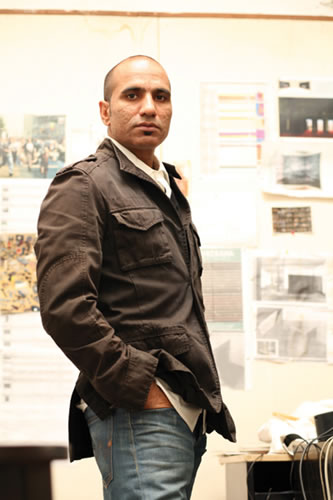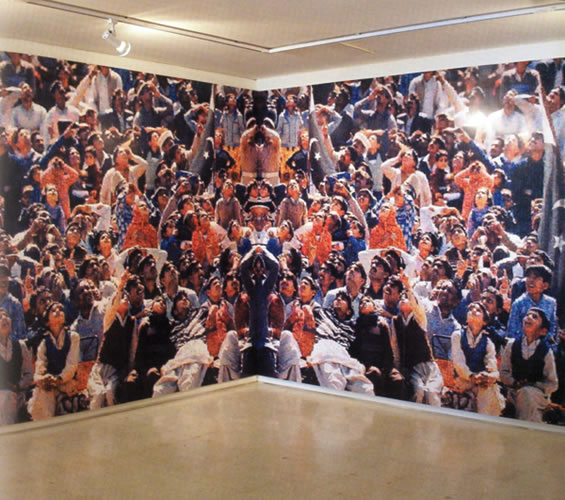In the last two decades simultaneous critical acclaim and art market triumph has made Rashid Rana a new archetype of success in the region. The list of his institutional exhibitions spans much of the globe and the galleries keenness to dedicate solo booths to him at major art fairs, attest to a growing confidence and interest in his art.
Rana is very much an artist of his time who has never seen limitations as a handicap and taken risks. In the mid 1990s by looking at popular imagery and increasing the scale of his work, an inspiration that came from Karachi Pop, rather than the overwhelmingly popular Neo Miniature around him, Rana set out to reach a greater audience. This steered his work in an independent direction better suited to conceptual exploration. While other artists were looking to galleries in the West for shows he hitched his star to the Indian gallery circuit and chose a Mumbai gallery to represent him. A controversial decision but the outreach of the Indian galleries not only opened doors to the international art market but gave him the edge with the art market boom in the region. His critical engagement in the art dialogue with Indian curators and critics led to inclusion in their projects giving him a place in the larger discourse. Remaining in his hometown and not giving it up for a diasporic existence, has been pivotal as it is the energy of the Lahore streets that sustain his practice as the critical chronicler.
‘By critically engaging with identity has become the new identity’ explains Rashid Rana ( 1) while talking about his inability to completely reject issues of identity. His identity embraces multiplicity and contradictions to free it from didacticism and resists the stereotypical constructs of ‘self’ and ‘the other’.
Fixed notions of nationalism and culture may have become passé in art discourse but its concerns have fragmented into different discursive directions and are still relevant to understand the power driven complex architecture of relationships, proximities and connectivities that inform contemporary art. Rasid Rana is quick to give Zahoorul Akhlaq, his mentor the credit of lifting ‘ the burden of identity’ from his generation of artists for it was he who empowered them with new ways of imaging the interface with history to connect it to lived experience. In Rana’s art, the street of Lahore through hundreds of micro images is a potent reference which engages conceptually with the formal language of art and its history in the genealogy of the West, to expand time identity into a global one.
By revisiting the aesthetics of painting and coupling it with new media the artist has consolidated a language that is increasingly recognized as his. The constant oscillation between the micro and the macro allows him to look at shifts within cultural perceptions through the lens of the colloquial and the intellectual simultaneously. This is seen in the Language Series that harvests Lahore’s linguistic register from the street, a map of how English has been transformed into a vernacular idiom. When these images are regurgitated into an abstract painting, a signifier of modern art, it invites reflection on how concepts of modernity enter the popular imagination.
The voracious appropriation of classical Western paintings, which with early works like ‘What is so Pakistani About This Painting’ comes under his digital scalpel to be sliced, titled and reworked to unpack multiple meanings. ‘Notions of Narrations’ exhibited in Milan (March 2014), based on a Renaissance painting by a Milanese artist is sliced into square tiles and rearranged with studied randomness to capture a distant echo of cubist masterpieces. The cleaving and destabilizing unleashes a destructive energy held in check by a taut spatial balance. Rana the painter is present and so is the conceptual artist who communicates the new balance of power through the act of dismantling. The morphing of the Renaissance legacy through its readings by diverse global cultures is also evoked The one constant is the Lahore urbanscape, which like DNA cells references his vantage point and animates the conceptual conversations with the markers of the dominant discourse of art history, a knowledge privileged by power and one that also privileges power, within this matrix identities are negotiated with acts of deconstruction and dismantling.
This kind of appropriation also spurred Zahoorul Akhlaq’s conceptual practice and in the 1990s, miniature paintings were altered with painterly devises. Images were often pushed beyond recognition and elements were isolated for formal investigation but the tenor was one of a poetic dialogue and the sensibility of miniature painting was not fully left behind. Pulled into the work with aggressive questioning and critical sparring Rana’s appropriation is more destabilizing and burdened with the trauma of a post- 9/11 world.
The tens of thousands of miniaturized images create central pivots for negotiation both as technique and a subject in the works. Even though it relies so heavily on found and exclusively shot images yet, Rana is quick to deny a deeper engagement with the discipline of photography and primarily sees his approach as that of a painter using the medium to address formal and conceptual issues. This ambivalence of being an artist tethered to formal concerns of painting and yet proactive in collapsing boundaries with technological manipulation creates yet another critical layer. What appears like an impregnable density of tiny images from a distance at close quarters become pulsating atoms embedded with meanings to baffle and act as a trigger for memory. Rana claims that duality, play with abstract representation, pop and minimalism and conceptual aesthetics are present in his work ( 2) he freely engaging with them to maintain the tension between the constant which is the photo mosaic technique and changing content.
In the early experiments with photo montages the macro micro formula conceptually addressed social paradoxes in the artist’s milieu, in the ‘Day in the Life of a Landscape’ , the audience stepped closer to find the constructed serenity of the rural landscape rudely shattered with tiny images of Lahore’s urban mayhem. The Dislocation Series flirt with time- based media as the still image of a building is constructed from micro images taken round the clock in changing light to interject time and movement.
Pushing it into the three dimensional, the reversal of scale of the pixels deliberately blurs the object forcing the audience to recognize its dislocation. This destabilizing is most acute in the bookshelves as the experience of seeing and not being able to see becomes a critical question. Constantly being fueled by challenges that question the way the brain reads spatial illusions on the two dimensional surface, the work ‘Off Shore Accounts’ in which the artist reverses the physical depth in the wall on which the work is installed to create an illusion of a flat surface . The layered interplay of ‘Desperately seeking Paradise’ locates it conceptually beyond the materiality of a city’s architecture. The work only concedes the full macro image hidden in the multiple apertures when the spectator walks around the cube to find the correct position. Framed in a grid, the two urbanscapes, the horizontal architecture of Lahore become the building blocks of generic vertical towers of any first world metropolis. This preoccupation with the city as an experience which is personal, historical and material was extended in Manchester with ‘See Through’ ( 2006) where the sights of Lahore transferred on dura film , seen from inside the gallery seem to project on to the local architecture, evoking the colonial history of factory workers from the villages of Punjab that built the textile empires of this industrial town. Titles like the ‘Labyrith of Reflections’, ‘Dislocation’, ‘Constant Paradox’ foreground the shifting meaning and uncertainty and alludes to embedded deceptions.
Important shows at prestigious museums and galleries like Musee Guimet, Manchester Biennale, at the Hong Kong Art Center, a comprehensive retrospective at Mohatta Palace Museum more recently at Lisson Gallery , Milan, testify to his international fame. At home he remains barely known outside art circles. The retrospective show at Mohatta Palace Museum in Karachi “ Labyrinth of Reflections ‘ which ran for one year did achieve the important task of showcasing the work comprehensibly but fell short on creating a dialogue around the work in the context of his time, location and critical relevance. It fell into the trap of the dated paradigm of exhibition as spectacle which is disconnected from the exhibition’s role as a discursive tool that has the power to intervene. The unwieldy catalog of the exhibition too echoed the philosophy that big is better which in weight and size, not to mention an exorbitant price tag, will find greater success as a collectors’ item rather than a document that gives access to Rana’s art.
Public programming makes a difference by helping visitors evolve from consumers into an engaged participants and has worked successfully in countries facing crisis were art is exploited for its agency to inform, sensitize and connect. Several precedents are available for child- friendly interventions, the activity booklet on Zahoorul Akhlaq conceptualized by Sheherezade Alam which circulated with a teacher’s manual, was a particularly successfully model.
The retrospective also brings into focus the relevance of Rashid Rana to his country and the people. His oeuvre with its distinctive way of looking at his own lived reality and the moment in history that he occupies has earned him a place with his peers at the apex. A larger engagement with his art has value for the people from whose location he speaks. Unlike poetry and film, contemporary visual art has to be de-coded and contextualized and the retrospective could have been an appropriate springboard for a wider understanding of Rana’s work and its place in conceptual art.
It would be a great loss if Rashid Rana was to be isolated and be looked upon only as a collectors’ favorite and his sharp social wit not made accessible to the man on the street who is the architect of popular culture and the protagonist with whom the artist shares the anxious age, and his art draws its legitimacy.
References
1& 2 – Interview of the artist with art critic/ curator Shaheen Merali, Nottingham, UK ,2012
Originally published in www.nuktaartmag.com Summer Issue 2014 ( www.nuktaartmag.com)
***
Karachi based Niilofur Farrukh is an art critic, curator, columnist ( Critical Space, Daily Dawn) and cultural activist. She is the Founder Editor of NuktaArt, (www.nuktaartmag.com). Currently President of AICA ( Int Art Critics Association, Paris) Pakistan, she also serves on the AICA International Commission on Freedom of Expression Commission. Her critical writings focus on art as a tool of societal change. She is the author of ‘Pioneering Perspectives’ and among other shows curated ‘No Honor in Killing, Making Visible Buried Truth’ that toured Pakistan from 2008 to 2010.







